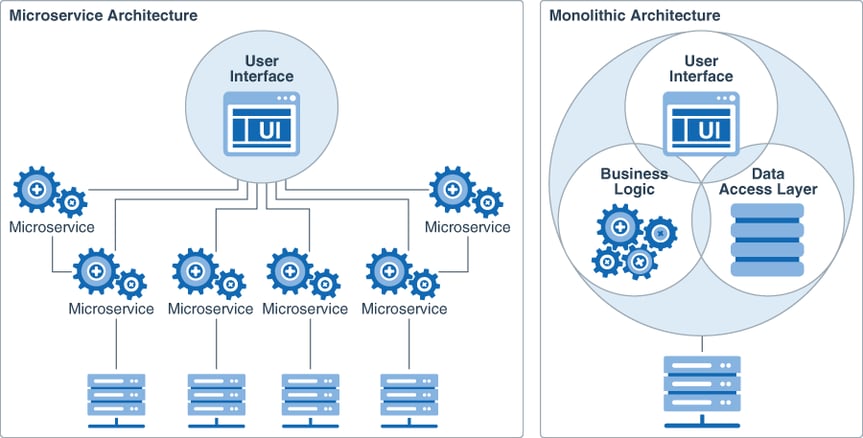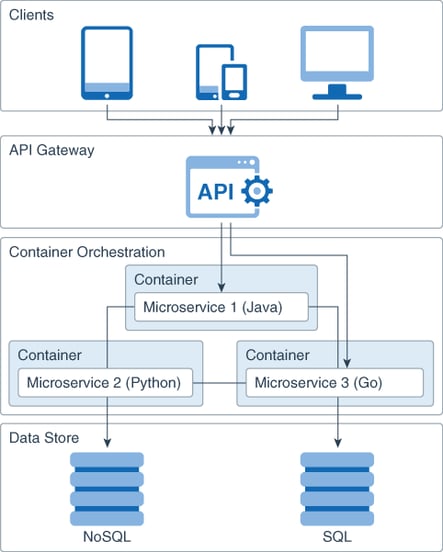Microservice architecture, commonly known as microservices, is a style of software development that divides software into modules with specific functions and intricate interfaces. In short, microservices rethink applications as a collection of several distinct, linked services. Each service is individually deployed and executes a unique workflow. The services may be created in other programming languages and can store and process data in various ways as desired.
This approach, which succeeds service-oriented architecture (SOA), offers agility (according to Forrester), efficiency, and short turnarounds. A distinct degree of business efficiency, accuracy, and scalability is accomplished because there is a stronger emphasis on enhancing each component and debugging it.
How do microservices work?
In the last several years, as businesses adopted DevOps and continuous testing practices to become more agile, microservices have increasingly popular. According to a Redhat Research, 73% of enterprises claim to have used microservices. In a second O'Reilly study, one-third of respondents claimed to be in the process of switching to a microservices design, and half said they intended to build most of their systems as microservices.
A significant number of enterprise businesses have abandoned monolithic architectures in favour of microservices, including Amazon, eBay, Netflix, PayPal, Twitter, and Uber. They trust this new architecture to run effectively without infrastructure issues.
Monolithic versus microservices architecture
All processes in a monolithic application substantially rely on one another and run as a single service. Since all the code in a monolithic application is deployed together on the same base, adding, or enhancing features becomes a complicated process, especially as the code base expands in size and complexity. Monolithic applications may also be vulnerable to failure. This is because if one process fails, tightly connected, fundamentally interdependent processes are immediately affected.
All of this means limitations on innovation and can make it challenging for businesses to remain flexible and responsive, which may put them at a disadvantage in a very dynamic, customer-focused market.
 Source: docs.oracle.com
Source: docs.oracle.com
Understanding the microservices architecture
Large programs may be divided into smaller, independently operating components thanks to microservices. Each piece is responsible for fulfilling its own tasks, and it is not dependent on the actions of the other parts to do so. To respond to user queries, a microservices-based application calls upon the combined services of these components.
Lightweight application programming interfaces (APIs) that link to detailed interfaces are used by the services in a microservices architecture to speak to one another. These services were developed to carry out specific business operations including processing payments, creating invoices, and handling data. Each service completes a single task. The services may be launched, updated, and expanded in accordance with the demand for each of their unique duties because they operate separately.
Microservices architecture creates flexible and scalable business solutions
The microservices architecture is the best fit for the current digital enterprises, especially because that can't always anticipate all the numerous kinds of devices that will use their infrastructure, microservices architecture is suitable.
Several monolithic apps were gradually redesigned to employ microservices as unanticipated requirements in the post-pandemic environment emerged. APIs may be used to modernize larger business systems by enabling communication between microservices and an outdated monolithic architecture.
Containers are a great illustration of a microservices architecture since they free organizations from having to worry about dependencies and allow them to concentrate on building services. Microservices are frequently used to build cloud-native apps using containers.
 Source: docs.oracle.com
Source: docs.oracle.com
The advantages of microservers
Both dev teams and processes will benefit from microservices' distributed development. In fact, 87% of microservices users agreed that microservices adoption is worth the expense and effort.
- Faster time to market: Microservices architecture allows for faster development cycles and more agile deployment, which means that products can be brought to market faster. Since each microservice is a standalone application, developers can work on different services simultaneously and make changes to each service without having to worry about impacting the rest of the application. This allows for more efficient testing and deployment, resulting in quicker turnaround times.
- Highly scalable: Microservices architecture is highly scalable, which means that it can handle increased demand without the need for significant changes to the overall system. Since each microservice is a separate application, it can be deployed across multiple servers and infrastructures, making it easier to handle large volumes of traffic. As demand grows for specific services, more resources can be allocated to those services, ensuring that the system remains stable and responsive.
- Resilient: Microservices architecture is designed to be resilient, meaning that the system can continue to function even if one or more services fail. Since each microservice is an independent application, a failure in one service does not necessarily mean a failure in the entire system. This makes the system more robust, reliable, and less prone to catastrophic failures.
- Easy to deploy: Microservices architecture is easier to deploy than traditional, monolithic apps. Because microservices are smaller and more modular, the deployment process is simpler and more manageable. The use of containerization technology and a service mesh layer can also help to make the deployment process smoother and more automated.
- Accessible: Microservices architecture is more accessible than traditional, monolithic apps. Since the application is broken down into smaller, more manageable pieces, developers can more easily understand, update, and enhance each service. This results in faster development cycles, which is especially beneficial when combined with agile development methodologies.
- More open: Microservices architecture is more open than traditional, monolithic apps. The use of polyglot APIs means that developers have more freedom to choose the best language and technology for the necessary function. This allows developers to work with the languages and tools that they are most comfortable with, resulting in more efficient and effective development. Additionally, the use of standardized APIs makes it easier to integrate with other systems and services. Then, existing services may be modified for usage in various situations without having to start from scratch with a new module.
Takeaways
Microservices deconstruct monolithic programs into smaller, easier-to-manage components. Microservices architecture provides many benefits for the right use case, but the shift might be difficult. Migrating to microservices will provide a distributed, loosely linked, and autonomous structure.
At Kubeark, we recognize the importance of helping businesses manage, monetize, and scale their apps efficiently. Kubeark provides businesses with a comprehensive microservices solution to manage the entire application development lifecycle, from deployment to scaling, to data analysis.
With this architecture, businesses can instantly deploy products to any environment while customizing to their unique business rules and needs. The ability to scale up or down seamlessly enables businesses to handle fluctuating demand, ensuring a smooth running without interruption.
By focusing on delivering value to customers, companies can rely on Kubeark to handle the technical details of marketplace transactions, while the platform turns data into actionable insights that drive better decision-making and improve the bottom line. Discover the full power of microservices with the Kubeark platform.

